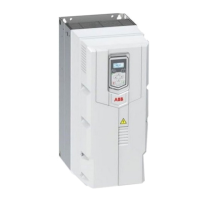66 Program features
See also section Operating modes of the drive (page 37).
IR compensation for scalar motor control
IR compensation (also known as
voltage boost) is available only when
the motor control mode is scalar. When
IR compensation is activated, the drive
gives an extra voltage boost to the
motor at low speeds. IR compensation
is useful in applications, such as
positive displacement pumps, that
require a high break-away torque.
Note: IR compensation is not possible
or required in vector control. The
compensation is applied automatically.
Settings
• Parameters 97.13 IR compensation (page 363)
• Main menu
Motor data or Main menu Complete parameter list
Parameter 99.04
.
• Parameter group 28 Frequency reference chain (page 240).
Vector control
Vector control is the motor control mode intended for applications where high control
accuracy is needed. It offers better control over the whole speed range, in particular
in applications where slow speed with high torque is needed.It requires an
identification run at startup. Vector control cannot be used in all applications, e.g. sine
filters.
Vector control is based on stator flux and motor torque values.
• Stator flux is calculated by integrating the motor voltage in vector space.
The estimate of stator flux can be improved by utilizing the identified motor model.
• Motor torque is calculated as a cross product of the stator flux and the rotor
current.
Both values can be achieved by controlling the output semiconductors switching. The
output frequency is changed only when the actual values of stator flux and motor
torque are different from their reference values by more than the allowed hysteresis.
The reference value for the torque controller comes from the speed controller or
directly from an external torque reference source.
Motor voltage
f (Hz)
IR compensation
No compensation

